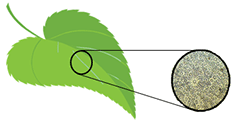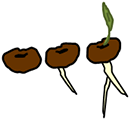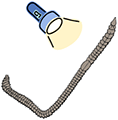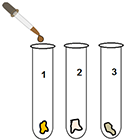
1. In science class, Michalea was studying the vascular system of plants. She cut the bottom off a stalk of celery and then placed the celery in colored water. She left the celery in the cup for 24 hours. When she observed the celery, she noticed that there were colored tubes in the celery stalk, which she knew was the xylem tissue. She cut off a piece of the celery and observed it under a dissecting microscope and drew her observations.
Feedback:

2. In science class, Jackson learned that the underside of many leaves contained structures called stomata. Water vapor and other gases exit the plant through the stomata. Jackson wondered if the leaves of a hibiscus plant or the leaves from an ivy plant had more stomata. He used clear fingernail polish to paint a 2 cm square area on the underside of each leaf. He then placed clear packing tape on each painted area and lifted the tape and removed an impression of the leaf. He placed the clear packing tape on microscope slides and then observed the impressions and counted the number of stomata on each leaf.
Feedback:

3. Robert was asked to determine how temperature affects enzyme activity. Potatoes placed in hydrogen peroxide were used as a source of the enzyme catalase. Robert tested the potatoes under three different conditions: potatoes at room temperature, potatoes that had been placed in an ice bath, and potatoes that had been placed in boiling water. The potatoes at room temperature served as his control group. He counted the bubbles that formed to determine enzyme activity.
Feedback:

4. Kaitlin performed an investigation in order to determine how pH affects the germination rate. She germinated bean seeds under three different conditions. The first one using distilled water with a pH of 7, second a solution with a pH of 5, and third a solution with a pH of 3. The beans in the distilled water served as her control group. The beans were given the same amount of light, same amount of liquid, and grown in the same containers.
Feedback:

5. Meredith completed an investigation involving earthworms. She placed a worm on a moist paper towel and carefully marked the position of the worm on the paper towel. She placed a cardboard box over the worm and paper towel and left it undisturbed for 10 minutes. She removed the box and noted that the worm had not moved from its original position. She then took a flash light and shined it on the worm for 10 minutes. After the end of the 10 minutes she measured the distanced the worm moved in cm.
Feedback:

6. During a laboratory investigation, Cole was trying to determine which foods contain starch. He had 3 unknown food samples. He placed 1 gram of each food sample into separate test tubes. He then added 2 drops of iodine to the test tube. The food samples that contained iodine turned black when the iodine was added.
Feedback: